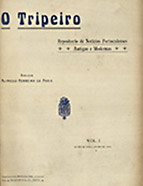

................................
A revival was attempted in the first half of 1919, driven by the founder’s determination and the encouragement of former collaborators and readers. This 2nd series consisted of 12 issues, retaining the original graphic and editorial style but adopting a fortnightly schedule. The publication aimed to safeguard and disseminate historical documentation related to the city of Porto and the northern region, now bolstered by the establishment of history courses at the 1st Faculdade de Letras [Faculty of Arts and Humanities] of Porto (1919–1931). However, the economic inflation of the post-war period, which had already necessitated page reductions to manage costs, likely contributed to the brief lifespan of this series. Notably, it featured first-time contributors such as J. A. Pires de Lima, Carlos de Passos, and António Arroio. Alfredo Ferreira de Faria made one final attempt to revive O Tripeiro with a 3rd series (1926–1927). After announcing the revival in a single issue at the end of 1925, the publication released two new volumes comprising 48 issues. This series faced scrutiny from the censorship committee and included a redesigned cover featuring engravings with small captions about monuments, personalities, heraldry, and lithographs. In the reformulation of certain sections, new features emerged, such as Jornaes da minha terra [Newspapers of My Land], Coisas do Passado [Things of the Past], and História Bairrista [Local History]. These additions highlighted themes related to institutions, the press, and notable personalities from Porto and its surrounding areas, which began to take centre stage. Unpublished contributions from regular collaborators and esteemed historians or intellectuals demonstrated greater care and historical rigour. Among these contributors were A. de Magalhães Basto, Júlio Dantas, Ruy de Serpa Pinto, Eduardo de Noronha, Armando de Matos, João Chagas, Raul Brandão, A. Pires de Lima, F. Macedo Lopes, Hernâni Monteiro, Alberto Meira, Kol de Alvarenga, and Cláudio Basto. The suspension of the publication, attributed to various economic and personal challenges faced by its director, caused considerable disappointment among a group of friends and contributors. This group honoured the director with a special issue in June 1928, after an unsuccessful fundraising campaign aimed at resuming publication. Later, in October 1930, they dedicated an in memoriam issue to him. This same centre ensured the legal registration of O Tripeiro through the incorporation of a company by the same name. It was also responsible for launching the 4th series (1930-1931) of what remained a monthly publication, with 12 new issues and a circulation of fewer than a hundred copies, under the direction of Emanuel Ribeiro. The inaugural editorial reaffirmed the core principles established in 1908, maintaining the main sections dedicated to study and current affairs while promising a broader focus on the city and its surrounding area. This included a greater emphasis on history, archaeology, urbanism, ethnography, philology, and the arts as a whole.
This work is financed by national funds through FCT - Foundation for Science and Technology, I.P, in the scope of the projects UIDB/04311/2020 and UIDP/04311/2020.
